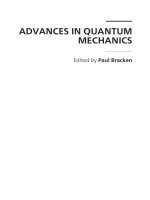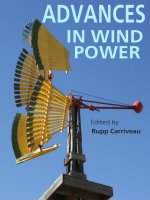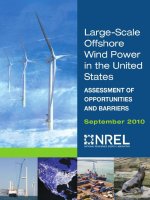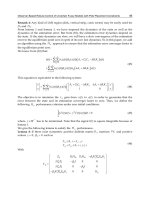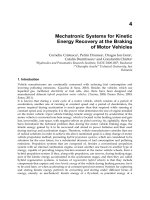Advances in Wind Power pot
Bạn đang xem bản rút gọn của tài liệu. Xem và tải ngay bản đầy đủ của tài liệu tại đây (18.78 MB, 374 trang )
POWER
ADVANCES
IN WIND
Edited by
Rupp Carriveau
ADVANCES IN WIND
POWER
Edited by Rupp Carriveau
Advances in Wind Power
/>Edited by Rupp Carriveau
Contributors
Hengameh Kojooyan Jafari, Mostafa Abarzadeh, Hossein Madadi Kojabadi, Liuchen Chang, Daniel MATT, Emilio
Gomez-Lazaro, Sergio Martín Martínez, Angel Molina-Garcia, Antonio Vigueras Rodriguez, Michael Milligan, Eduard
Muljadi, Adrian Ilinca, David Wood, Ed Nowicki, Mohamed Fahmy Aner, Samer El Itani, Géza Joós, Mahmoud Huleihil,
Karam Youssef Maalawi, Fernando Ponta, Alejandro Otero, Lucas Ignacio Lago, Wenping Cao, Ying Xie, Zheng Tan,
Horizon Gitano, João Paulo Vieira, Rupp Carriveau, Tim Newson, Philip McKay, David S-K Ting
Published by InTech
Janeza Trdine 9, 51000 Rijeka, Croatia
Copyright © 2012 InTech
All chapters are Open Access distributed under the Creative Commons Attribution 3.0 license, which allows users to
download, copy and build upon published articles even for commercial purposes, as long as the author and publisher
are properly credited, which ensures maximum dissemination and a wider impact of our publications. After this work
has been published by InTech, authors have the right to republish it, in whole or part, in any publication of which they
are the author, and to make other personal use of the work. Any republication, referencing or personal use of the
work must explicitly identify the original source.
Notice
Statements and opinions expressed in the chapters are these of the individual contributors and not necessarily those
of the editors or publisher. No responsibility is accepted for the accuracy of information contained in the published
chapters. The publisher assumes no responsibility for any damage or injury to persons or property arising out of the
use of any materials, instructions, methods or ideas contained in the book.
Publishing Process Manager Iva Simcic
Technical Editor InTech DTP team
Cover InTech Design team
First published November, 2012
Printed in Croatia
A free online edition of this book is available at www.intechopen.com
Additional hard copies can be obtained from
Advances in Wind Power, Edited by Rupp Carriveau
p. cm.
ISBN 978-953-51-0863-4
Contents
Preface VII
Section 1 Inflow and Wake Influences on Turbine Performance 1
Chapter 1 Wind Turbine Power: The Betz Limit and Beyond 3
Mahmoud Huleihil and Gedalya Mazor
Chapter 2 Effect of Turbulence on Fixed-Speed Wind Generators 31
Hengameh Kojooyan Jafari
Chapter 3 Turbine Wake Dynamics 65
Phillip McKay, Rupp Carriveau, David S-K Ting and Timothy Newson
Section 2 Turbine Structural Response 85
Chapter 4 Aeroelasticity of Wind Turbines Blades Using
Numerical Simulation 87
Drishtysingh Ramdenee, Adrian Ilinca and Ion Sorin Minea
Chapter 5 Structural Analysis of Complex Wind Turbine Blades: Flexo-
Torsional Vibrational Modes 123
Alejandro D. Otero, Fernando L. Ponta and Lucas I. Lago
Section 3 Power Conversion, Control, and Integration 151
Chapter 6 Recent Advances in Converters and Control Systems for Grid-
Connected Small Wind Turbines 153
Mohamed Aner, Edwin Nowicki and David Wood
Chapter 7 Wind Turbine Generator Technologies 177
Wenping Cao, Ying Xie and Zheng Tan
Chapter 8 A Model for Dynamic Optimization of Pitch-Regulated Wind
Turbines with Application 205
Karam Y. Maalawi
Chapter 9 Comparative Analysis of DFIG Based Wind Farms Control Mode
on Long-Term Voltage Stability 225
Rafael Rorato Londero, João Paulo A. Vieira and Carolina de M.
Affonso
Chapter 10 Design of a Mean Power Wind Conversion Chain with a
Magnetic Speed Multiplier 247
Daniel Matt, Julien Jac and Nicolas Ziegler
Chapter 11 Low Speed Wind Turbine Design 267
Horizon Gitano-Briggs
Chapter 12 Wind Power Variability and Singular Events 285
Sergio Martin-Martínez, Antonio Vigueras-Rodríguez, Emilio
Gómez-Lázaro, Angel Molina-García, Eduard Muljadi and Michael
Milligan
Chapter 13 Power Electronics in Small Scale Wind Turbine Systems 305
Mostafa Abarzadeh, Hossein Madadi Kojabadi and Liuchen Chang
Chapter 14 Advanced Wind Generator Controls: Meeting the Evolving Grid
Interconnection Requirements 337
Samer El Itani and Géza Joós
ContentsVI
Preface
Today’s wind energy industry is at a crossroads. Global economic instability has threatened
or eliminated many financial incentives that have been important to the development of
specific markets. Such economic sponsorship of energy generation is not unique to
renewables; fossil based sources are also subsidized in many different countries. However,
for a technology like wind energy whose markets are still developing, incentives can be
critical for industry growth. Industry proponents have decreed that long-term energy policy
that survives financial swings and changes in government is what is needed to provide the
stability that market investors seek. While this may be the case, in the mean time, the
pressure is on wind industry designers, manufacturers, and operators to seek the most
effectual measures for wind power production.
Like the wind itself, the industry operates on large and small scales. While large commercial
wind has traditionally received the most coverage in the literature and the media, small
wind has recently established itself as a major player in distributed energy systems. This
will become increasingly important as micro grids rapidly find their place in both the
developed and developing worlds. In urban and isolated rural settings, small wind is
growing rapidly. It is important to emphasize this multi-scale resilience that wind
generation provides as an energy solution. The broad range of scales within wind energy is
only surpassed by the expansive scope of technologies that cover the spectrum from
resource assessment to grid integration. Specialized sub-topics continue to emerge that
provide focus for improving critical links in the wind chain. This sort of specificity can be
vital for isolating technical elements from the complexity of interconnected wind energy
systems. A brief list of emerging specific interest fields include aerodynamic interaction of
wind turbine groups, computational modeling of complex composite blades, magnetic
speed multiplying converters, generator controls optimized for small wind, disturbance
tolerant generators, micro and smart grid integration.
This text details topics fundamental to the efficient operation of modern commercial farms
and highlights advanced research that will enable next-generation wind energy
technologies. The book is organized into three sections, Inflow and Wake Influences on
Turbine Performance, Turbine Structural Response, and Power Conversion, Control and
Integration. In addition to fundamental concepts, the reader will be exposed to
comprehensive treatments of topics like wake dynamics, analysis of complex turbine blades,
and power electronics in small-scale wind turbine systems.
Dr. Rupp Carriveau
Department of Civil and Environmental Engineering,
Windsor, Canada
Section 1
Inflow and Wake Influences on Turbine
Performance
Chapter 1
Wind Turbine Power: The Betz Limit and Beyond
Mahmoud Huleihil and Gedalya Mazor
Additional information is available at the end of the chapter
/>1. Introduction
With a severe energy crisis facing the modern world, the production and utilization of ener‐
gy has become a vital issue, and the conservation of energy has acquired prime importance.
Energy production and consumption are directly related to everyday life in much of human
society, and issues of energy research are extremely important and highly sensitive. Being
aware of the global warming problem, humans tend to rely more on renewable energy (RE)
resources.
1.1. Benefits of wind energy
In [1], scientists and researchers have tried to accelerate solutions for wind energy genera‐
tion design parameters. Researchers claim that a short time, society, industry, and politics
will welcome the use of wind energy as a clean, practical, economical, and environmentally
friendly alternative. In an effort to approach a more sustainable world, after the 1973 oil cri‐
sis RE sources began to appear on the agenda, and wind energy attracted significant inter‐
est. Because of extensive studies on this topic, wind energy has recently been applied in
various industries, where it has begun to compete with other energy resources [1].
Among the various renewable energy types as highlighted by [2], wind provides an inter‐
mittent but environmentally friendly energy source that does not pollute atmosphere. Wind
power calculations are initiated from the kinetic energy definition, and wind power is found
to be proportional to half the air density multiplied by the cube of the wind velocity. When
seeking to determine the potential usage of wind energy, wind power formulation is de‐
rived first by use of kinetic energy definition and then by basic physical definitions of power
as the ratio of work over time, work as the force multiplied by the distance, and force as the
change of momentum. [2].
1.2. Aerodynamics aspects of wind turbines
Reviews about many of the most important aerodynamic research topics in the field of wind
energy are shown in the report of a different study [3] Wind turbine aerodynamics concerns
the modeling and prediction of aerodynamic forces, such as performance predictions of
wind farms, as well as the design of specific parts of wind turbines, such as rotor-blade ge‐
ometry. The basics of blade-element momentum theory were presented along with guide‐
lines for the construction of airfoil data. Various theories for aerodynamically optimum
rotors were discussed, and recent results on classical models were presented. State-of-the-art
advanced numerical simulation tools for wind turbine rotors and wakes were reviewed, in‐
cluding rotor predictions as well as models for simulating wind turbine wakes and flows in
wind farms [3].
1.3. Wind power density
Concerning power density and its relation to wind speed, the report given in [4] pre‐
sented the features of wind power distributions that were analytically obtained from
wind distribution functions. Simple equations establishing a relationship between mean
power density and wind speed have been obtained for a given location and wind tur‐
bine. Different concepts relating to wind power distribution functions were shown—
among them the power transported by the wind and the theoretical maximum converti‐
ble power from wind, according to the Betz’ law. Maximum convertible power from the
wind was explained within more realistic limits, including an approximate limit to the
maximum power from a wind turbine, was obtained. In addition, different equations
were obtained establishing relationships between mean power density and mean wind
speed. These equations are simple and useful when discarding locations for wind tur‐
bine installation [4].
1.4. Wind power applications
The range of wind power usage is scarce. One of the most important usages is electrici‐
ty. Hubbard and Shepherd [5] considered wind turbine generators, ranging in size from
a few kilowatts to several megawatts, for producing electricity both singly and in wind
power stations that encompass hundreds of machines. According to the researchers’
claims, there are many installations in uninhabited areas far from established residences,
and therefore there are no apparent environmental impacts in terms of noise. The re‐
searchers do point out, however, situations in which radiated noise can be heard by res‐
idents of adjacent neighborhoods, particularly those who live in neighborhoods with low
ambient noise levels [5].
Wind power is used worldwide, not only in developed countries. Specific studies [6, 7]
presented a detailed study of a Manchegan windmill while considering the technologi‐
cal conditions of the original Manchegan windmills. In addition, a wind evaluation of
the region was carried out, the power and momentum of the windmills were calculat‐
ed, and the results obtained were discussed, along with a comparison with the type of
Advances in Wind Power
4
Southern Spanish windmill. These windmills were important for wheat milling and had
been an important factor in the socio-economic development of rural Spain for centu‐
ries [6, 7].
Another example is considered in [8]. This study, conducted with reference to land in
Syria, evaluated both wind energy potential and the electricity that could be generated
by the wind. An appropriate computer program was especially prepared and designed
to perform the required calculations, using the available meteorological data provided
by the Syrian Atlas. The program is capable of processing the wind data for any specific
area that is in accordance with the needed requirements in fields of researches and ap‐
plications. Calculations in the study show that a significant energy potential is available
for direct exploitation. The study also shows that approximately twice the current elec‐
tricity consumption in Syria can be generated by wind resources [8].
The potential usage of wind power at Kudat and Labuan for small-scale energy demand
was given in [9]. According to their statement, the acquisition of detailed knowledge
about wind characteristics at a site is a crucial step in planning and estimating perform‐
ance for a wind energy project. From this study, the researchers concluded that sites at
Kudat and Labuan that they had considered during the study years were unsuitable for
large-scale wind energy generation. However, they did confirm that small-scale wind en‐
ergy could be generated at a turbine height of 100 meters [9]. In light of their findings,
James and others [10] reported that the potential impact of the UK’s latest policy instru‐
ment, the 2010 micro-generation tariffs, is considered applicable to both micro-wind and
photovoltaics.As the researchers observed, building-mounted micro-wind turbines and
photovoltaics have the potential to provide widely applicable carbon-free electricity gen‐
eration at the building level. Because photovoltaic systems are well understood it is easy
to predict performance using software tools or widely accepted yield estimates. Micro-
wind research, however, is far more complex, and in comparison, it is poorly under‐
stood [10].
Abdeen [11] addresses another example of wind power usage. As the researcher observed,
the imminent exhaustion of fossil energy resources and the increasing demand for energy
were the motives for Sudanese authorities to put into practice an energy policy based on ra‐
tional use of energy. The authorities also based their conclusions on exploitation of new and
renewable energy sources. It was pointed out that after 1980, as the supply of conventional
energy has not been able to follow the tremendous increase in production demand in rural
areas of Sudan; a renewed interest for the application of wind energy has been shown in
many places. Therefore, the Sudanese government began to pay more attention to wind en‐
ergy utilization in rural areas. Because the wind energy resource in many rural areas is suffi‐
cient for attractive application of wind pumps, although as fuel it is insufficient, the wind
pumps will be spread on a rather large scale in the near future. Wind is a form of renewable
energy that is always in a non-steady state due to the wide temporal and spatial variations
of wind velocity. Results suggested that wind power would be more profitably used for lo‐
cal and small-scale applications, especially for remote rural areas. The study finds that Su‐
dan has abundant wind energy [11]. Another recent study [12] considered the wind power
Wind Turbine Power: The Betz Limit and Beyond
/>5
in Iran. According to the study’s claims, climate change, global warming, and the recent
worldwide economic crisis have emphasized the need for low carbon emissions while also
ensuring economic feasibility. In their paper, the researchers investigated the status and
wind power potential of the city of Shahrbabak in Kerman province in Iran. The technical
and economic feasibility of wind turbine installation was presented, and the potential of
wind power generation was statistically analyzed [12].
1.5. Types of wind turbines
There are different types of wind turbines: bare wind turbines, augmented wind turbines,
horizontal axis wind turbines, and vertical axis wind turbines, just to mention a few.
1.5.1. Bare wind turbines
According to research findings as given by [13], the derivation of the efficiency of an ideal
wind turbine is attributed to the three prominent scientists associated with the three princi‐
pal aerodynamic research schools in Europe during the first decades of the previous centu‐
ry: Lanchester, Betz, and Joukowsky. According to this study, detailed reading of their
classical papers had shown that Lanchester did not accept that the velocity through the disc
is the average of the velocities far upstream and far downstream, by which his solution is
not determined. Betz and Joukowsky used vortex theory to support Froude’s result and de‐
rived the ideal efficiency of a wind turbine at the same time. This efficiency has been known
as the Joukowsky limit in Russia and as the Betz limit everywhere else. As the researchers
suggested, because of the contribution of both scientists, this result should be called the
Betz-Joukowsky limit everywhere [13]. The maximal achievable efficiency of a wind turbine
is found to be given by the Betz number B = 16/27. Derivation of the classical Betz limit
could be followed as given by [14] and [15].
The question of the maximum wind kinetic energy that can be utilized by a wind turbine,
which is of fundamental importance for employment of wind energy, was reconsidered in
[16]. According to their study, the researchers observed that in previous studies, an answer
to this question was obtained only for the case of an infinite number of turbine-rotor blades,
in the framework of application of the one-dimensional theory of an ideal loaded disk with‐
out loss for friction and turbulence taken into account. This implies that for an ideal wind
turbine, the maximum energy that can be extracted from the wind kinetic energy, or the
power coefficient, does not exceed the Betz limit. Based on the exact calculation of the Gold‐
stein function, the researchers determined the maximum power coefficient of an ideal wind
turbine having a finite number of blades. As was expected, the maximum turned out to be
always lower than the absolute Lanchester-Betz-Joukowski limit. According to their find‐
ings, with an increase in the number of blades, the power coefficient rises approaching the
estimate of Glauert for a rotor with an infinite number of blades, only if by taking wake flow
twisting into account [16].
In a different proposal, Cuerva and Sanz-Andre´s presented an extended formulation of the
power coefficient of a wind turbine [17]. Their formulation was a generalization of the Betz-
Advances in Wind Power
6
Lanchester expression for the power coefficient as a function of the axial deceleration of the
wind speed provoked by the wind turbine in operation. The extended power coefficient
took into account the benefits of the power produced and the cost associated to the produc‐
tion of this energy. By means of the proposed simple model, the researchers evidenced that
the purely energetic optimum operation condition giving rise to the Betz-Lanchester limit
(maximum energy produced) does not coincide with the global optimum operational condi‐
tion (maximum benefit generated) if cost of energy and degradation of the wind turbine
during operation is considered. The new extended power coefficient, according to the re‐
searchers claim, is a general parameter useful to define global optimum operation condi‐
tions for wind turbines, considering not only the energy production but also the
maintenance cost and the economic cost associated to the life reduction of the machine [17].
1.5.2. Augmented wind turbines
It was suggested in [18] that one could extract more power from the wind by directing the
wind by a diffuser that could be incorporated into the system. The benefit of such a device is
to decrease the size of the system and thus decrease its cost [18].
According to [19], the performance of a diffuser-augmented wind turbine has been estab‐
lished by matching the forces acting on the blade element to overall momentum and energy
balances. Good agreement with experimental data was obtained [19]. Based on computa‐
tional fluid dynamics (CFD), an actuator disc CFD model of the flow through a wind turbine
in a diffuser was developed and validated [20, 21]. Their research presumed a flow increase
could be induced by a diffuser. They showed that from a one-dimensional analysis the Betz
limit could be exceeded by a factor that is proportional to the relative increase in mass flow
through the rotor. This result was verified by theoretical one-dimensional analysis by the
CFD model [20, 21]. Supporting the same idea, [22] Sharpe stated that it is theoretically pos‐
sible to exceed the Lanchester-Betz limit. His study presented a general momentum theory
for an energy-extracting actuator disc that modeled a rotor with blades having radially uni‐
form circulation. The study included the effects of wake rotation. Although the study re‐
ports that the general momentum theory is well known, the fall in pressure that is caused by
the rotation of the wake that the theory predicts, is not usually recognized. Accounting for
the wake rotational pressure drop changes some of the established conclusions of the mo‐
mentum theory that appear in the literature. The conclusion from the study is that the theo‐
ry establishes no loss of efficiency associated with the rotating wake [22]. Experimental and
numerical investigations for flow fields of a small wind turbine with a flanged diffuser were
carried out in [23].
The considered wind-turbine system gave a power coefficient higher than the Betz limit,
which they attributed to the effect of the flanged diffuser. The experimental and numerical
results gave useful information about the flow mechanism behind a wind turbine with a
flanged diffuser. In particular, a considerable difference was seen in the destruction process
of the tip vortex between the bare wind turbine and the wind turbine with a flanged diffuser
[23]. According to the findings given in [24], suitable techniques to convert a country's wind
availability (mostly in the low-speed regimes) as a renewable energy source must be scruti‐
Wind Turbine Power: The Betz Limit and Beyond
/>7
nized in order to achieve effective and efficient conversion. In this study, the researchers de‐
scribed efforts to step up the potential power augmentation offered by the Diffuser
Augmented Wind Turbine (DAWT). Modification of the internal profile of the diffuser oc‐
curred by replacing the interior profile of the diffuser with an optimized airfoil shape as the
interior profile of the diffuser. Additional velocity augmentation of approximately 66%
could be achieved with the optimized profile when compared to a diffuser with an original
flat interior [24]. As was pointed out in [25, 26], although there is an increase in maximum
performance of a DAWT that is proportional to the mass flow of air, with application of sim‐
ple momentum theory, the amount of energy extracted per unit of volume with a DAWT is
the same as for an ordinary bare wind turbine [25, 26].
1.6. Modeling controversy
Debate is ongoing around the issue of DAWT. In a recent study, a general momentum theo‐
ry to study the behavior of the classical free vortex wake model of Joukowsky was used [27].
This model, as the researchers reported, has attained considerable attention as it shows the
possibility of achieving a power performance that greatly exceeds the Lanchester-Betz limit
for rotors running at low tip speed ratios. This behavior was confirmed even when includ‐
ing the effect of a center vortex, which, without any simplifying assumptions, allowed azi‐
muthal velocities and the associated radial pressure gradient to be taken into account in the
axial momentum balance. In addition, a refined model that remedies the problem of using
the axial momentum theorem was proposed. Using this model the power coefficient never
exceeds the Lanchester-Betz limit, but rather tends to zero at a zero tip speed ratio [27]. As
asserted in [28], for reasons of energy and momentum conservation a conventional diffuser
system, as it is commonly used in water turbines cannot augment the power of a wind tur‐
bine beyond the Betz limit. However, if the propeller of the turbine is embedded into an ex‐
ternal flow of air from which by means of its static structure energy can be transferred to the
internal flow through the propeller, the propeller can supersede the Betz limit with respect
to this internal flow [28]. Features of such practical methods toward achieving such im‐
provements in wind power are discussed in [29].
1.7. Blades design
According to the report given by [30], the main problem of a wind turbine generator design
project is the design of blades capable of satisfying, with optimum performance, the specific
energy requirement of an electric system [30]. Simulations are very important to facilitate
engineering and design of wind turbines for many reasons, especially those that concentrate
upon reducing cost and saving human time. With regard to the designing the rotor blades, a
CFD model for the evaluation of energy performance and aerodynamic forces acting on a
straight-bladed vertical-axis Darrieus wind turbine was presented [31]. A modified blade el‐
ement momentum theory for the counter-rotating wind turbine was developed [32]. This en‐
abled the investigation of the effects of design parameters such as the combinations of the
pitch angles, rotating speeds, and radii of the rotors on the aerodynamic performance of the
counter-rotating wind turbine [32].
Advances in Wind Power
8
1.8. Wind farms
Vermeer and others surveyed wind farms. The focus of this study was on standalone tur‐
bines and wind farm effects. The survey group suggested that when assembling many wind
turbines together, several issues should be considered [33]. Other research studies discussed
the issue of optimizing the placement of wind turbines in wind farms [34]. Factors consid‐
ered included multidirectional winds and variable wind speeds, the effect of ambient turbu‐
lence in the wake recovery, the effect of ground, variable hub height of the wind turbines,
and different terrains [34]. A review of the state of the art and present status of active aeroe‐
lastic rotor control research for wind turbines was presented in [35]. A wind farm controller
was reported in [36]. That controller distributes power references among wind turbines
while it reduces their structural loads.
In this study the effect of losses are considered and discussed for bare wind turbines and for
shrouded wind turbines.
2. One-dimensional fluid dynamics models
In this section, one-dimensional fluid dynamics models are analyzed and formulated based
on the extended Bernoulli equation [37], accounting for losses that are assumed to be pro‐
portional to the square of the velocity of the air crossing the rotor blades of the wind turbine.
The performance characteristics of the wind turbine are given by the power and thrust coef‐
ficients. The efficiency of the wind turbine is addressed and its relation to the power coeffi‐
cient is discussed.
While developing a model to describe the performance of a wind turbine, common assump‐
tions regarding the fluid flow are as follows [18]:
1. The entire field is one-dimensional.
2. The fluid considered is not compressible.
3. The flow field in the proximity of the turbine is a pure axial flow.
Other assumptions are given for the specific models.
2.1. Bare wind turbine
Consider a wind turbine that intercepts the flow of air moving with velocity V
0
. The differ‐
ent quantities involved in the physics of the moving air are the pressure, p, the velocity, V,
the cross section area, A (at different locations along the stream lines), and the thrust on the
blades of wind turbine, T. The upstream condition is identified with a subscript of zero, the
downstream condition is identified with a subscript of 3, and the turbine locations are iden‐
tified by subscripts of 1, 2, and t (see Figure 1).
Wind Turbine Power: The Betz Limit and Beyond
/>9
t
Figure 1. Schematics of the bare wind turbine. In the upper part, airstream lines are shown crossing the turbine's ro‐
tor. The velocity of the air at the rotor is the same based on the mass flow rate: V
1
=V
2
=V
t
.The pressure drop is deter‐
mined by ∆p=p
1
-p
2
.
The steady state mass flow rate is given by:
.
m VA const
r
= =
&
(1)
The modified Bernoulli equation (with reference to the turbine head), which describes the
energy balance through the wind turbine, is written between the entrance and exit sections,
and is given by:
2 2
0 0 0 3
1 1
2 2
t loss
p V p V
h h
g g
g g
+ = + + +
(2)
In this equation h
t
is the head of the turbine (related to the amount of power extraction), h
loss
represents the head losses, and
γ
is the specific weight. The loss term in the energy equation
Advances in Wind Power
10
accounts for friction (mechanical and fluid) and is assumed proportional to the kinetic ener‐
gy of the rotor blades, expressed as follows:
2
2
t
loss loss
V
h C
g
=
(3)
Equations (2) and (3) are rearranged and the head of the turbine is given by:
2 2 2
0 3
1 1
2 2 2
t
t loss
V V V
h C
g g g
= - -
(4)
The power output from the turbine, P, is given by:
2 2
3
3
0
0 0 0
1
1
2
t t
t t t t loss
V V V
P V A h V A C
V V V
g r
æ ö
æ ö æ ö
ç ÷
= = - -
ç ÷ ç ÷
ç ÷ ç ÷
ç ÷
è ø è ø
è ø
(5)
From equation (5) we can determine the power coefficient, C
P,
by:
2 2
3
3
0 0 0
0
1
1
2
t t
P loss
t
V V V
P
C C
V V V
V A
r
æ ö
æ ö æ ö
ç ÷
= = - -
ç ÷ ç ÷
ç ÷ ç ÷
ç ÷
è ø è ø
è ø
(6)
The developed thrust, T, on the turbine blades is given by the linear moment equation (see
[15] for more details), as follows:
0 3
( )
t t
T V A V V
r
= -
(7)
The thrust coefficient, C
T,
based on equation (7), is given by:
3
2
0 0
0
2 1
1
2
t
T
t
V V
T
C
V V
V A
r
æ ö
= = -
ç ÷
ç ÷
è ø
(8)
Equations (5) and (7) are governed by the following relationship:
t
P TV=
(9)
Wind Turbine Power: The Betz Limit and Beyond
/>11
By observation, the velocity of air decreases toward the downstream. Therefore, we can sim‐
plify calculations by introducing the parameter, a, to express the velocity at the cross section
of the turbine, and the upstream velocity can be determined by:
0
(1 ) 0 1
t
V a V a= - < <
(10)
Equating equations (5) and (9) gives the velocity of the air, V
3
, at the downstream, and after
some algebraic manipulation, it could be shown to be given by:
( )
( )
2
2 *
3 0
1 1
loss
V a a C a V
æ ö
= - - - -
ç ÷
è ø
(11)
The normalized loss coefficient is defined by:
* 2
0loss loss
C C V=
(12)
Equations (11) and (12) are useful to calculate the power coefficient (equation (6)) and the
thrust coefficient (equation (8)). For the case where the losses are negligible, the known re‐
sults in the literature are reproduced and given by the following equations:
The downstream velocity is given by:
3
1 2V a= -
(13)
The power coefficient is given by:
( )
2
4 1
P
C a a= -
(14)
The thrust coefficient is given by:
( )
4 1
T
C a a= -
(15)
Inversing the relation given in equation (15), the parameter, a, is given as a function of C
T
by:
1 1
2
T
C
a
- -
=
(16)
Advances in Wind Power12
Finally, the power coefficient as a function of the thrust coefficient is given by:
1
2
T T t
P
C C C
C
+ -
=
(17)
2.2. Augmented wind turbine
In order to exploit wind power as economically as possible, it was suggested that the wind
turbine should be enclosed inside a specifically designed shroud [38, 39]. Several models
were reported in the literature to analyze wind turbine rotors surrounded by a device
(shroud), which was usually a diffuser [18, 25, and 26]. Others suggested different ap‐
proaches [28].
In this section, the extended Bernoulli equation and mass and momentum balance equations
are used to analyze the augmented wind turbine. The power coefficient and the thrust coef‐
ficients are derived, accounting for losses in the same manner as was done for the bare tur‐
bine case. The efficiency of the wind turbine could be defined as the ratio of the net power
output to the energy input to the system. The efficiency based on this definition agrees with
the Betz limit.
The schematics of the shrouded wind turbine are shown in Figure 2.
Figure 2. Schematics of the shrouded wind turbine. There is a vertical element at the exit of the wind turbine. This
element contributes to reducing the power at the downstream side of the turbine, an effect that extracts more air
through the wind turbine. (Idea reproduced similar to the description given by Ohya [40].)
This type of design has been recently reported [40], and it was shown that the power coeffi‐
cient is about 2-5 times greater when compared to the performance of the bare wind turbine.
The vertical part at the exit of the shroud reduces the pressure and therefore, the wind tur‐
bine draws more mass.
The balance equations are followed in the same manner as for the bare wind turbine. The
modified Bernoulli equation differs by the pressure at the exit and is given by:
Wind Turbine Power: The Betz Limit and Beyond
/>13
2 2
0 0 3 3
1 1
2 2
t loss
p V p V
h h
g g
g g
+ = + + +
(18)
The pressure drop between inlet and outlet (p
0
-p
3
) is rewritten as proportional (with C
F
pro‐
portionality coefficient) to the difference in kinetic energies and it is given by:
( )
2 2
0 3 0 3
1
2
F
p p p V V C
r
D = - = -
(19)
The power coefficient for the shrouded wind turbine is given by:
( )
2 2
3
3
0 0 0
0
1 1
1
2
t t
P F loss
t
V V V
P
C C C
V V V
V A
r
æ ö
æ ö
æ ö æ ö
ç ÷
ç ÷
= = + - -
ç ÷ ç ÷
ç ÷ ç ÷
ç ÷
ç ÷
ç ÷
è ø è ø
è ø
è ø
(20)
The thrust coefficient is given by:
( )
3
2
0 0
0
2 1 1
1
2
t
T F
t
V V
T
C C
V V
V A
r
æ ö
= = + -
ç ÷
ç ÷
è ø
(21)
Manipulating equations (9)-(12) makes it possible to produce sample plots to consider in the
next section.
2.3. Wind turbine efficiency
Usually, efficiency is defined as the ratio between two terms: the amount of net work, w, to
the input, q
in,
energy to the device. Efficiency can be alternatively defined as the ratio be‐
tween the derived power, P
out,
and the rate of energy flowing to the system, P
in
. Based on
these definitions, the efficiency of power generating machine is given by:
net out
in in
w P
q P
h
= =
(22)
As was observed by Betz, the maximal achievable efficiency of the bare wind turbine is giv‐
en by the Betz number B = 16/27. In section 2.1, the power coefficient of the bare turbine was
considered under the assumption of frictional losses. In this case, the power coefficient can
also be identified as the efficiency of the wind turbine in this case. However, the power coef‐
ficient for the shrouded wind turbine as considered in section 2.2 is not efficiency. Based on
Advances in Wind Power
14
the definition of efficiency, one could observe that if we divide the power coefficient by the
factor (CF + 1) (taking into account the increased mass flow to the system due to pressure
drop), a similar expression of the shrouded wind turbine could be given by equation (6).
Thus, according to the modeling assumptions and with special care in treatment of the loss
coefficient, one could conclude that the efficiency of the wind turbine could not exceed the
Betz limit, although the power coefficient in general could exceed the Betz limit, as was ob‐
served previously by others.
2.4. Maximum windmill efficiency in finite time
In a different approach, a model to estimate the efficiency of a wind turbine was introduced
[41] and the efficiency at maximum power output η
mp
was derived. Although the power de‐
veloped in a wind turbine derives from kinetic energy rather than from heat, it was possible
to view the basic model of the wind turbine in a schematic way, which is similar to the heat
engine picture. After the wind turbine accepts energy input in its upstream side, it extracts
power at the turbine blades and ejects energy at the downstream. Details of this approach
are given elsewhere [41].
The derived value for the efficiency at maximum power operation was shown to be a func‐
tion of the Betz number, B, and is given by the following formula:
1 1
mp
B
h
= - -
(23)
This value is 36.2%, which agrees well with those for actually operating wind turbines.
With an algebraic manipulation this expression could be approximated by:
2
2
mp
B
B
h
=
-
(24)
The expression given in equation (24) differs by only a small percentage when compared to
equation (23). With the aid of equation (24), one could estimate the efficiency as 8/23.
As compared to the efficiency of heat engines, the system efficiency could be defined as the
mean value between the maximum efficiency (Carnot efficiency) and the efficiency at maxi‐
mum power point (Curzon-Ahlborn efficiency). Thus, the efficiency of the wind turbine sys‐
tem
η
ts
could be given by:
(
)
1 1
2
ts
B B
h
+ - -
=
(25)
Wind Turbine Power: The Betz Limit and Beyond
/>15
If equation (23) is used while neglecting the contribution of the Number B/2 compared to 2,
the turbine efficiency given by equation (24) would be approximated by:
3
4
ts
B
h
=
(26)
2.5. Wind turbine efficiency and the golden section
The golden section has been considered in different disciplines as a measure of beauty
[42-49]. The schematics of the golden section are given in Figure 3.
Figure 3. Schematics of the golden ratio. In the upper part to the left, the oval shape is divided into two parts, x and 1-
x. in the upper part to the right, the same oval is divided into two parts with the following engine parameters: W
represents the net work output; E
out
represents the energy left the machine. E
in
represents the energy that was put into
the machine. In the lower part, a construction of the golden section is depicted by the isosceles triangle with a base
angle of 72°. Comparing the different parts, x is defined as W/E
in
or E
out
/E
in
, depending upon parts that have been
produced and rejected.
In the upper part of the figure, the oval shape is divided into two parts, x and 1-x (as can be
seen in the left side of the figure). In the right side, the same oval shape depicts the relation
to quantities considered in engine machines. In the lower part of Figure 3, a golden section
construction is depicted using the isosceles triangle with sides of unity and base triangle of
72°. If we apply the result of the golden section ratio (the golden section ratio is related to
the sine of the angle of 18º, thus
2sin(18)=
5−1
2
) to wind power efficiency, which is usually
defined as the work gained divided by the energy input to the system, we can observe that
the Betz limit agrees very well to the golden section (0.593 compared to 0.618). We can also
Advances in Wind Power
16
see that the practical efficiencies of wind turbines in the proximity of 40% are comparable
with the smaller part of the golden section 38.2%.
The golden section beauty can be related to wind turbines if we recall that the kinetic energy
of the wind usually splits into two parts: useful and rejected. According to the Betz limit,
about 60% of the energy is used to produce electric power and the rest is rejected. On the
other hand, the real wind turbines extract about 40% and the rest is wasted. These findings
are in match with the golden section division (61.8% and 38.2%). One could conclude by
asking: Is this just a fortuitous result or is there something more deep and inherent in the
beauty of nature?
2.6. Factors that affect the efficiency of the wind turbine
In terms of wind turbine efficiency, it is possible to highlight different parts of the turbine
when estimating its value. Most of the studies discussed above considered extracting power
from the kinetic energy of the wind. This could be defined as kinetic energy efficiency
η
KE
.
Other considerations should be accounted for, such as the mechanical efficiency, η
me
(when
power is decreased due to mechanical friction), the conversion to electricity efficiency,η
con
,
and the blockage efficiency,
η
bl
(which is defined as the amount of air blocked by the turbine
blades as depicted by Figure 4). The overall turbine efficiency is given by:
net bl con me KE
h h h h h
=
(27)
Figure 4. Schematic of the cross section of the rotor blades. The cross section illustrates the fact that the physical body of the rotor blades blocks
some of the air particles, reducing potential power production from the air. The blocking efficiency can be defined as
1
rotor
bl
cross
A
A
. In this
equation, A
rotor is the projected cross section of the rotor blades and Across is the cross section without the rotor blades.
3. Numerical considerations
In this section sample, plots of the results are considered.
3.1. The ideal bare wind turbine model
The one-dimensional bare wind turbine model without losses has been treated extensively and is well documented in textbooks
[15]. The velocity of the air crossing the wind turbine velocity is assumed to be a fraction of the upstream air velocity. This fraction
is introduced as a parameter, a, which expresses the ratio between the latter and the former. Parameter a is assigned a value in the
range of numbers between zero and one. It is important to note that the physical range of this parameter is limited, for example,
0<a<0.5, otherwise the velocity at the downstream becomes negative. To help clarify this point, calculations were performed
covering the full range of parameter a. Equations (6) and (8) give the power coefficient and the thrust coefficient, respectively.
Figure 5 shows these coefficients as functions of parameter a (a very well-known result in the professional literature in the field).
Figure 5. Power and thrust coefficients for the ideal bare wind turbine as a function of the parameter a (the ratio between the air velocity crossing
the turbine blades and the upstream velocity of the air). The plot is reproduced similar to what is known in the literature, but highlighting the
physical region (0<a<0.5) with thicker black color and the non-physical region (0.5<a<1) with thinner red color.
For explicit presentation, the physical range of parameter a (up to the value of 1/2) was drawn in a thick black color, while the rest
of the plot was prepared using a thinner red color. It is clear from the figure that the coefficients vanish at the zero and one values
of the parameter. In between, the maximum thrust coefficient (with a value of unity) occurs at the value of a=1/2. On the other
Power and thrust coefficients for the bare wind
turbine with zero loss coefficeint vs. the parameter a
0
0.1
0.2
0.3
0.4
0.5
0.6
0.7
0.8
0.9
1
0 0.1 0.2 0.3 0.4 0.5 0.6 0.7 0.8 0.9 1
a
Power and thrust coefficients
.
0<a <0.5
0.5<a<1
Figure 4. Schematic of the cross section of the rotor blades. The cross section illustrates the fact that the physical body
of the rotor blades blocks some of the air particles, reducing potential power production from the air. The blocking
efficiency can be defined as
η
bl
=1 −
A
rotor
A
cross
. In this equation, A
rotor
is the projected cross section of the rotor blades and
A
cross
is the cross section without the rotor blades.
Wind Turbine Power: The Betz Limit and Beyond
/>17
